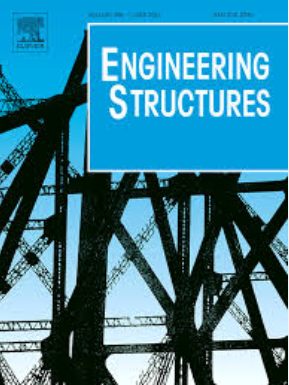Performance of inter-module connection with a pegged tenon for composite modular buildings with CFST columns
IF 5.6
1区 工程技术
Q1 ENGINEERING, CIVIL
引用次数: 0
Abstract
The global rise of modular building, with its standardized manufacturing, faster construction, and superior quality, has been a significant trend. Steel-concrete composite modular buildings are emerging as a promising solution to address the increasing capacity demand resulting from the growing design height of modular buildings in various applications, including residential buildings, hotels, and offices. The use of concrete-filled steel tubular (CFST) columns effectively increases the capacity of modular units. However, this also results in higher load demand for inter-module connections, posing a significant challenge for conventional designs. This paper introduces a new tenon-connected inter-module connection for composite modular buildings, in which the tenon is pegged with tightening bolts driven through it perpendicularly. This innovative design offers a reliable load path to ensure continuity between the connected columns, while also allowing for easy assembly. An experimental test was conducted on six full-scale connection specimens to study their structural performance under monotonic loading. Four distinct failure modes were observed, and the corresponding load-displacement relation and strain distribution were thoroughly evaluated. A detailed finite element analysis (FEA) model was developed and validated against test data, which was then used to conduct a parametric study to investigate the influence of key parameters on the connection performance. The study revealed that variations in the column, brace, and tenon parameters greatly influenced the connection failure mode and loading capacity. The findings of this study provided a reference for the safe design of novel inter-module connections for composite modular buildings.
求助全文
约1分钟内获得全文
求助全文
来源期刊

Engineering Structures
工程技术-工程:土木
CiteScore
10.20
自引率
14.50%
发文量
1385
审稿时长
67 days
期刊介绍:
Engineering Structures provides a forum for a broad blend of scientific and technical papers to reflect the evolving needs of the structural engineering and structural mechanics communities. Particularly welcome are contributions dealing with applications of structural engineering and mechanics principles in all areas of technology. The journal aspires to a broad and integrated coverage of the effects of dynamic loadings and of the modelling techniques whereby the structural response to these loadings may be computed.
The scope of Engineering Structures encompasses, but is not restricted to, the following areas: infrastructure engineering; earthquake engineering; structure-fluid-soil interaction; wind engineering; fire engineering; blast engineering; structural reliability/stability; life assessment/integrity; structural health monitoring; multi-hazard engineering; structural dynamics; optimization; expert systems; experimental modelling; performance-based design; multiscale analysis; value engineering.
Topics of interest include: tall buildings; innovative structures; environmentally responsive structures; bridges; stadiums; commercial and public buildings; transmission towers; television and telecommunication masts; foldable structures; cooling towers; plates and shells; suspension structures; protective structures; smart structures; nuclear reactors; dams; pressure vessels; pipelines; tunnels.
Engineering Structures also publishes review articles, short communications and discussions, book reviews, and a diary on international events related to any aspect of structural engineering.
 求助内容:
求助内容: 应助结果提醒方式:
应助结果提醒方式:


